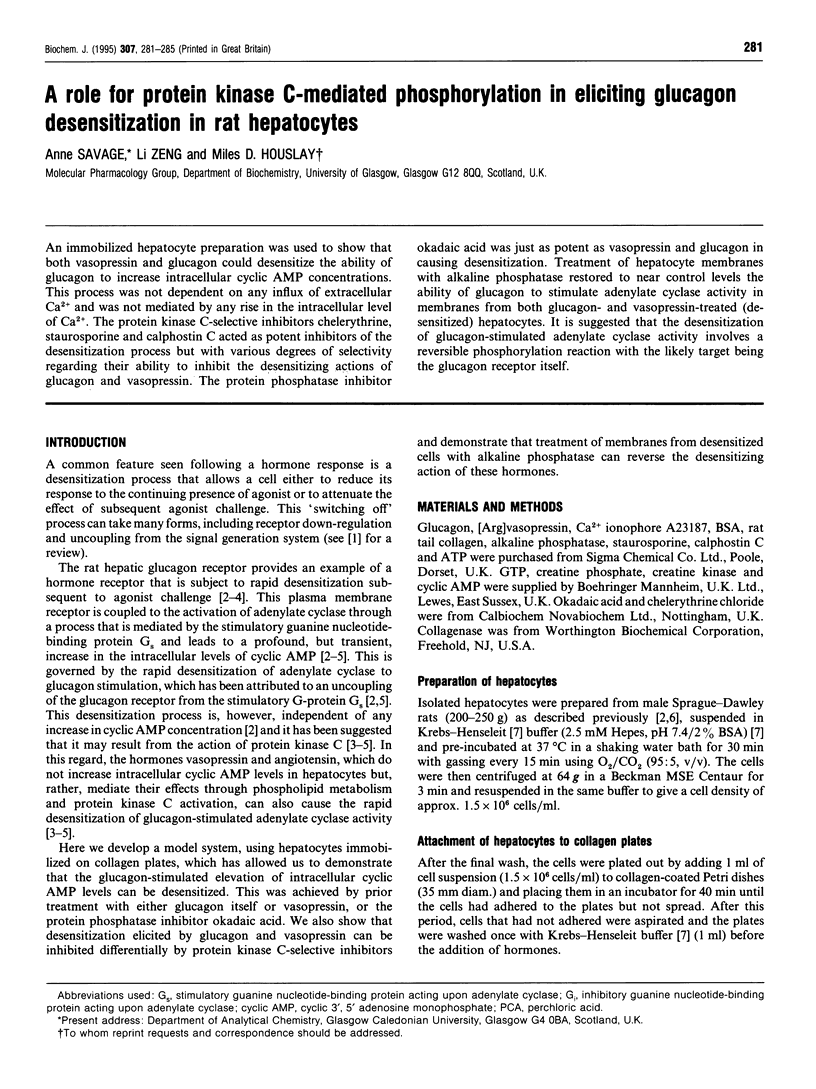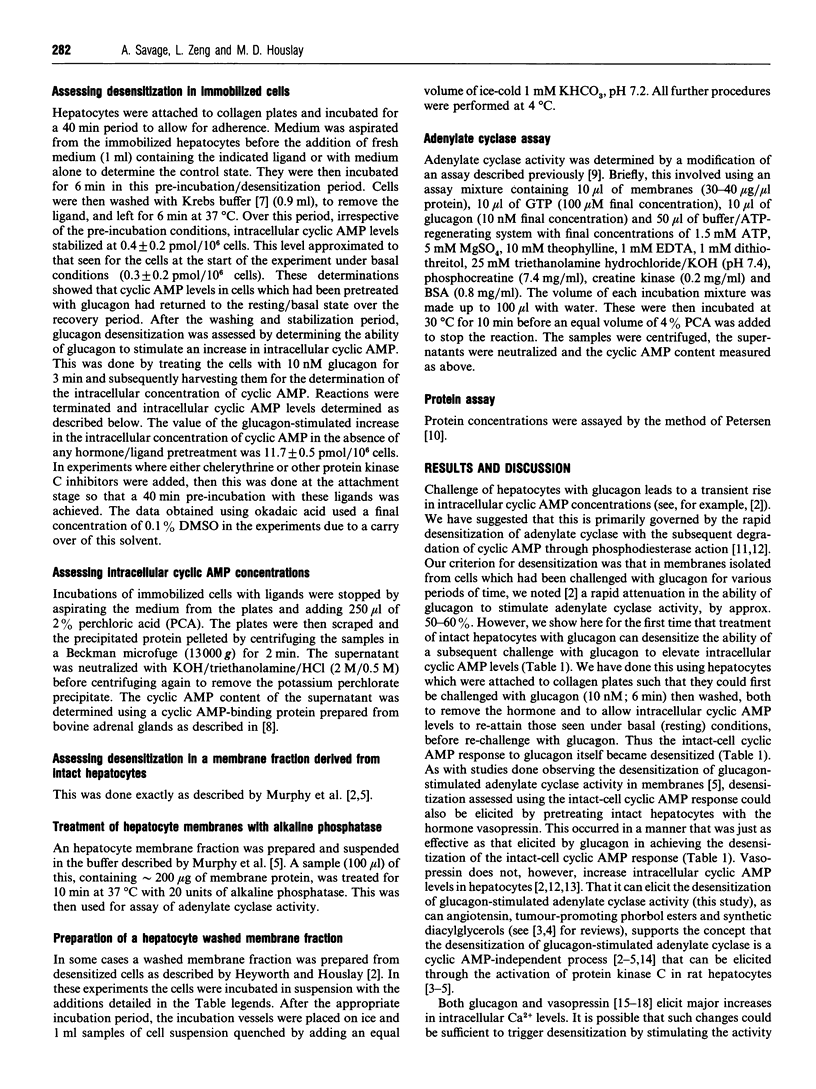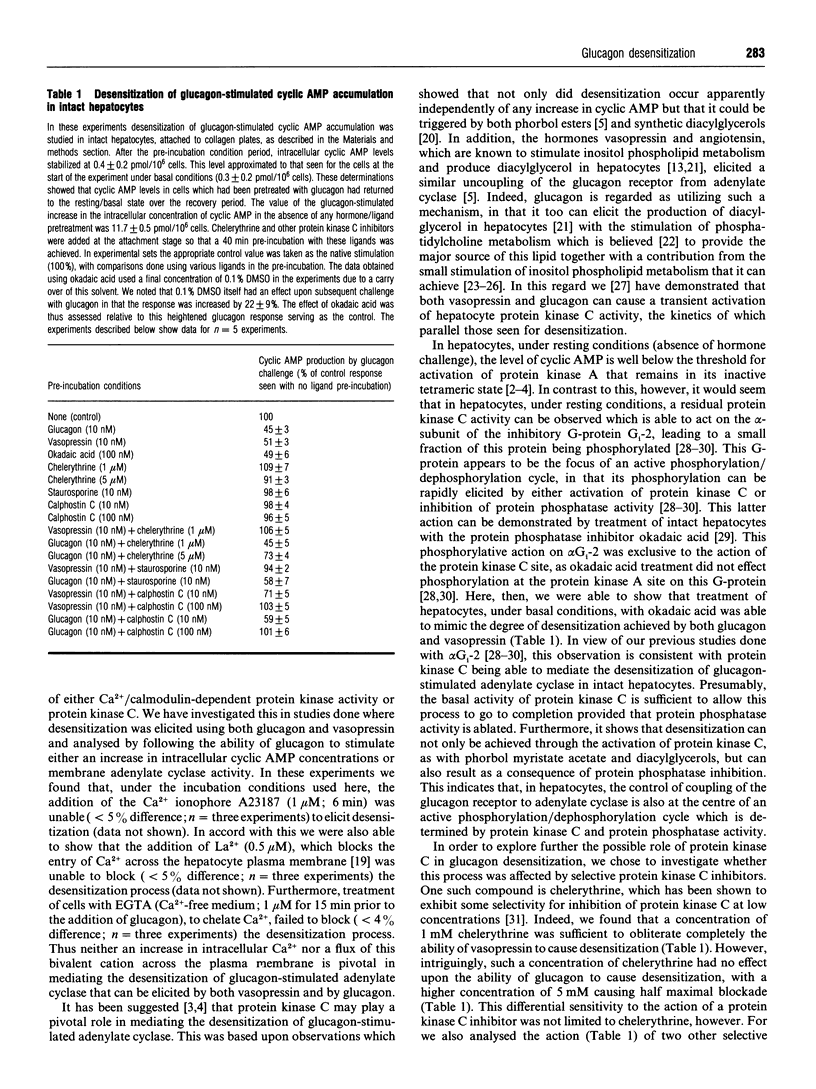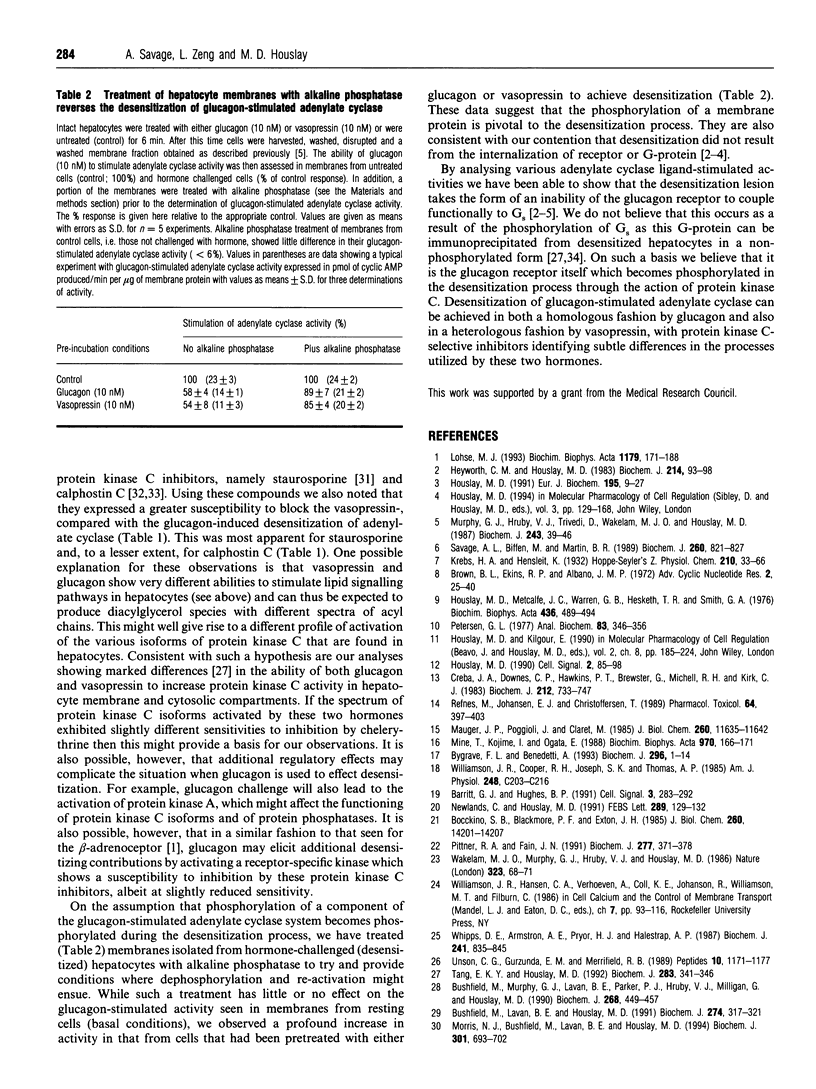Abstract
An immobilized hepatocyte preparation was used to show that both vasopressin and glucagon could desensitize the ability of glucagon to increase intracellular cyclic AMP concentrations. This process was not dependent on any influx of extracellular Ca2+ and was not mediated by any rise in the intracellular level of Ca2+. The protein kinase C-selective inhibitors chelerythrine, staurosporine and calphostin C acted as potent inhibitors of the desensitization process but with various degrees of selectivity regarding their ability to inhibit the desensitizing actions of glucagon and vasopressin. The protein phosphatase inhibitor okadaic acid was just as potent as vasopressin and glucagon in causing desensitization. Treatment of hepatocyte membranes with alkaline phosphatase restored to near control levels the ability of glucagon to stimulate adenylate cyclase activity in membranes from both glucagon- and vasopressin-treated (desensitized) hepatocytes. It is suggested that the desensitization of glucagon-stimulated adenylate cyclase activity involves a reversible phosphorylation reaction with the likely target being the glucagon receptor itself.
Full text
PDF




Selected References
These references are in PubMed. This may not be the complete list of references from this article.
- Barritt G. J., Hughes B. P. The nature and mechanism of activation of the hepatocyte receptor-activated Ca2+ inflow system. Cell Signal. 1991;3(4):283–292. doi: 10.1016/0898-6568(91)90056-z. [DOI] [PubMed] [Google Scholar]
- Brown B. L., Ekins R. P., Albano J. D. Saturation assay for cyclic AMP using endogenous binding protein. Adv Cyclic Nucleotide Res. 1972;2:25–40. [PubMed] [Google Scholar]
- Bushfield M., Lavan B. E., Houslay M. D. Okadaic acid identifies a phosphorylation/dephosphorylation cycle controlling the inhibitory guanine-nucleotide-binding regulatory protein Gi2. Biochem J. 1991 Mar 1;274(Pt 2):317–321. doi: 10.1042/bj2740317. [DOI] [PMC free article] [PubMed] [Google Scholar]
- Bushfield M., Murphy G. J., Lavan B. E., Parker P. J., Hruby V. J., Milligan G., Houslay M. D. Hormonal regulation of Gi2 alpha-subunit phosphorylation in intact hepatocytes. Biochem J. 1990 Jun 1;268(2):449–457. doi: 10.1042/bj2680449. [DOI] [PMC free article] [PubMed] [Google Scholar]
- Bygrave F. L., Benedetti A. Calcium: its modulation in liver by cross-talk between the actions of glucagon and calcium-mobilizing agonists. Biochem J. 1993 Nov 15;296(Pt 1):1–14. doi: 10.1042/bj2960001. [DOI] [PMC free article] [PubMed] [Google Scholar]
- Creba J. A., Downes C. P., Hawkins P. T., Brewster G., Michell R. H., Kirk C. J. Rapid breakdown of phosphatidylinositol 4-phosphate and phosphatidylinositol 4,5-bisphosphate in rat hepatocytes stimulated by vasopressin and other Ca2+-mobilizing hormones. Biochem J. 1983 Jun 15;212(3):733–747. doi: 10.1042/bj2120733. [DOI] [PMC free article] [PubMed] [Google Scholar]
- Herbert J. M., Augereau J. M., Gleye J., Maffrand J. P. Chelerythrine is a potent and specific inhibitor of protein kinase C. Biochem Biophys Res Commun. 1990 Nov 15;172(3):993–999. doi: 10.1016/0006-291x(90)91544-3. [DOI] [PubMed] [Google Scholar]
- Heyworth C. M., Houslay M. D. Challenge of hepatocytes by glucagon triggers a rapid modulation of adenylate cyclase activity in isolated membranes. Biochem J. 1983 Jul 15;214(1):93–98. doi: 10.1042/bj2140093. [DOI] [PMC free article] [PubMed] [Google Scholar]
- Hidaka H., Inagaki M., Kawamoto S., Sasaki Y. Isoquinolinesulfonamides, novel and potent inhibitors of cyclic nucleotide dependent protein kinase and protein kinase C. Biochemistry. 1984 Oct 9;23(21):5036–5041. doi: 10.1021/bi00316a032. [DOI] [PubMed] [Google Scholar]
- Houslay M. D. 'Crosstalk': a pivotal role for protein kinase C in modulating relationships between signal transduction pathways. Eur J Biochem. 1991 Jan 1;195(1):9–27. doi: 10.1111/j.1432-1033.1991.tb15671.x. [DOI] [PubMed] [Google Scholar]
- Houslay M. D., Metcalfe J. C., Warren G. B., Hesketh T. R., Smith G. A. The glucagon receptor of rat liver plasma membrane can couple to adenylate cyclase without activating it. Biochim Biophys Acta. 1976 Jun 17;436(2):489–494. doi: 10.1016/0005-2736(76)90210-8. [DOI] [PubMed] [Google Scholar]
- Houslay M. D. The use of selective inhibitors and computer modelling to evaluate the role of specific high affinity cyclic AMP phosphodiesterases in the hormonal regulation of hepatocyte intracellular cyclic AMP concentrations. Cell Signal. 1990;2(1):85–98. doi: 10.1016/0898-6568(90)90036-a. [DOI] [PubMed] [Google Scholar]
- Lohse M. J. Molecular mechanisms of membrane receptor desensitization. Biochim Biophys Acta. 1993 Nov 7;1179(2):171–188. doi: 10.1016/0167-4889(93)90139-g. [DOI] [PubMed] [Google Scholar]
- Mauger J. P., Poggioli J., Claret M. Synergistic stimulation of the Ca2+ influx in rat hepatocytes by glucagon and the Ca2+-linked hormones vasopressin and angiotensin II. J Biol Chem. 1985 Sep 25;260(21):11635–11642. [PubMed] [Google Scholar]
- Mine T., Kojima I., Ogata E. Evidence of cyclic AMP-independent action of glucagon on calcium mobilization in rat hepatocytes. Biochim Biophys Acta. 1988 Jun 30;970(2):166–171. doi: 10.1016/0167-4889(88)90175-9. [DOI] [PubMed] [Google Scholar]
- Morris N. J., Bushfield M., Lavan B. E., Houslay M. D. Multi-site phosphorylation of the inhibitory guanine nucleotide regulatory protein Gi-2 occurs in intact rat hepatocytes. Biochem J. 1994 Aug 1;301(Pt 3):693–702. doi: 10.1042/bj3010693. [DOI] [PMC free article] [PubMed] [Google Scholar]
- Murphy G. J., Hruby V. J., Trivedi D., Wakelam M. J., Houslay M. D. The rapid desensitization of glucagon-stimulated adenylate cyclase is a cyclic AMP-independent process that can be mimicked by hormones which stimulate inositol phospholipid metabolism. Biochem J. 1987 Apr 1;243(1):39–46. doi: 10.1042/bj2430039. [DOI] [PMC free article] [PubMed] [Google Scholar]
- Newlands C., Houslay M. D. Treatment of intact hepatocytes with synthetic diacyl glycerols mimics the ability of glucagon to cause the desensitization of adenylate cyclase. FEBS Lett. 1991 Sep 9;289(2):129–132. doi: 10.1016/0014-5793(91)81051-9. [DOI] [PubMed] [Google Scholar]
- Peterson G. L. A simplification of the protein assay method of Lowry et al. which is more generally applicable. Anal Biochem. 1977 Dec;83(2):346–356. doi: 10.1016/0003-2697(77)90043-4. [DOI] [PubMed] [Google Scholar]
- Pittner R. A., Fain J. N. Activation of membrane protein kinase C by glucagon and Ca(2+)-mobilizing hormones in cultured rat hepatocytes. Role of phosphatidylinositol and phosphatidylcholine hydrolysis. Biochem J. 1991 Jul 15;277(Pt 2):371–378. doi: 10.1042/bj2770371. [DOI] [PMC free article] [PubMed] [Google Scholar]
- Pyne N. J., Murphy G. J., Milligan G., Houslay M. D. Treatment of intact hepatocytes with either the phorbol ester TPA or glucagon elicits the phosphorylation and functional inactivation of the inhibitory guanine nucleotide regulatory protein Gi. FEBS Lett. 1989 Jan 16;243(1):77–82. doi: 10.1016/0014-5793(89)81221-9. [DOI] [PubMed] [Google Scholar]
- Refsnes M., Johansen E. J., Christoffersen T. Glucagon-induced refractoriness of hepatocyte adenylate cyclase: comparison of homologous and heterologous components and evidence against a role of cAMP. Pharmacol Toxicol. 1989 May;64(5):397–403. doi: 10.1111/j.1600-0773.1989.tb00675.x. [DOI] [PubMed] [Google Scholar]
- Savage A. L., Biffen M., Martin B. R. Vasopressin-stimulated Ca2+ influx in rat hepatocytes is inhibited in high-K+ medium. Biochem J. 1989 Jun 15;260(3):821–827. doi: 10.1042/bj2600821. [DOI] [PMC free article] [PubMed] [Google Scholar]
- Tang E. K., Houslay M. D. Glucagon, vasopressin and angiotensin all elicit a rapid, transient increase in hepatocyte protein kinase C activity. Biochem J. 1992 Apr 15;283(Pt 2):341–346. doi: 10.1042/bj2830341. [DOI] [PMC free article] [PubMed] [Google Scholar]
- Unson C. G., Gurzenda E. M., Merrifield R. B. Biological activities of des-His1[Glu9]glucagon amide, a glucagon antagonist. Peptides. 1989 Nov-Dec;10(6):1171–1177. doi: 10.1016/0196-9781(89)90010-7. [DOI] [PubMed] [Google Scholar]
- Wakelam M. J., Murphy G. J., Hruby V. J., Houslay M. D. Activation of two signal-transduction systems in hepatocytes by glucagon. Nature. 1986 Sep 4;323(6083):68–71. doi: 10.1038/323068a0. [DOI] [PubMed] [Google Scholar]
- Whipps D. E., Armston A. E., Pryor H. J., Halestrap A. P. Effects of glucagon and Ca2+ on the metabolism of phosphatidylinositol 4-phosphate and phosphatidylinositol 4,5-bisphosphate in isolated rat hepatocytes and plasma membranes. Biochem J. 1987 Feb 1;241(3):835–845. doi: 10.1042/bj2410835. [DOI] [PMC free article] [PubMed] [Google Scholar]
- Williamson J. R., Cooper R. H., Joseph S. K., Thomas A. P. Inositol trisphosphate and diacylglycerol as intracellular second messengers in liver. Am J Physiol. 1985 Mar;248(3 Pt 1):C203–C216. doi: 10.1152/ajpcell.1985.248.3.C203. [DOI] [PubMed] [Google Scholar]


